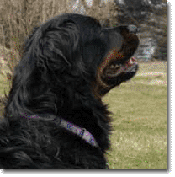
![]()
What is Clicker Training?
It is training using almost entirely positive reinforcement - teaching your dog to learn... using no physical compulsion or corrections whatsoever. Sounds a bit unbelievable, but works incredibly well. Instead of yanking dogs around, shoving them into place, giving some praise, and hoping the dog will make the connection, dogs are taught using the scientific methods of classical & operant conditioning. Anyone questioning how reliable a dog taught this way can be should take a trip to Sea World. There, the Orcas, dolphins, etc., are taught using these same methods. After all... you can't slip a choke chain around a whale's neck & give a jerk! And yet, these lovely creatures perform flawlessly for audience after audience. And have a blast doing it. The whole enjoyment feature is what really turned me on to positive training. I love my dogs, and although I want them to be responsive to me I dislike hurting them! With clicker training I don't have to. This training works for every dog, from bold to timid, from tiny to giant. This is the type of training used for most (all?) animals trained for movie & TV work, too.
The clicker itself is simply a little toy-like device that is used in the initial stages of training any behavior. It provides clear & precise communication between owner & dog and allows you both to concentrate on & enjoy the task at hand. You click at the exact moment the dog is performing whatever it is you want, and since you always follow that click with a tasty treat, the dog will learn to love the sound, and the work to make that sound happen! As part of the training, you teach the dog hand and/or verbal signals for each behavior. As the dog learns these, you phase out the clicker. It has completed its function, which was to communicate to your dog which behavior you desired.
With positive reinforcement training there is no more forcing a dog to learn. Instead, the dog becomes eager to learn! Very tasty food treats are the primary reinforcers at first because they are easy to use but many, many other reinforcements are used as well - from squeaky toys to playing games. A dog properly trained this way will not be dependent upon food in order to respond.
Clicker training can be used to teach your dog (or just about any animal) regular pet obedience type behaviors (such as loose-leash walking) as well as more advanced competition, trick or service behaviors. You will love it... and so will your dog!
Mary Woodward & Susan Greenholt
Greenwood Dog Training School
Wilmington, DE
using positive methods to teach people how to teach their pets!
last updated 03/01/09
site created & maintained by Mary Woodward
copyright © 2002 Mary Woodward
All Rights Reserved


